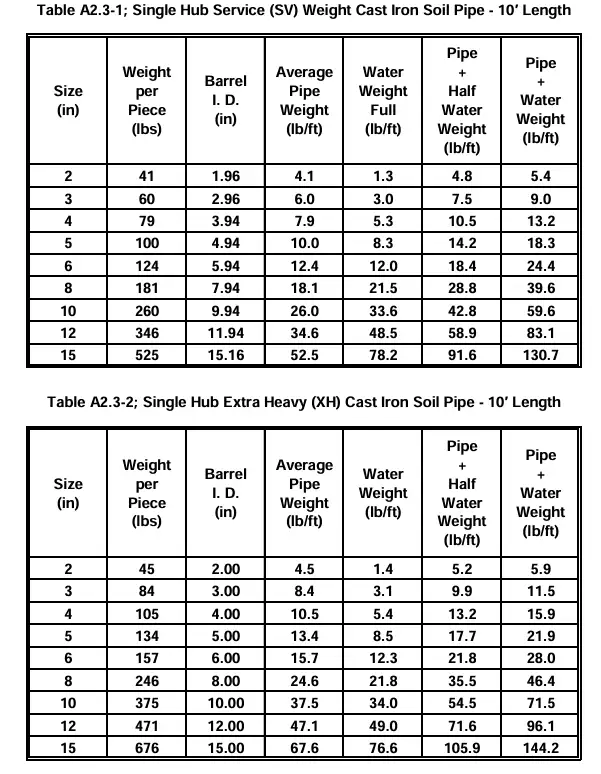After installing countless cast iron pipes, I can confirm their weight varies dramatically by size and wall thickness. A standard 10-foot length of 4-inch diameter cast iron pipe weighs around 40 lbs (18 kg), while a 6-inch diameter pipe of the same length tips the scales at nearly 70 lbs (32 kg).

1. What Is Cast Iron Pipe?
Cast‑iron pipe is a hollow, strong iron alloy with 2–4 % carbon and other elements. It’s been used for centuries in water and wastewater systems, valued for rigidity and longevity.
There are two main types:
-
Grey cast iron (brittle, machinable)
-
Ductile iron (nodular graphite, more flexible, higher strength).
In engineering contexts, “cast iron pipe” typically refers to grey iron for soil/drainage and ductile for mains. In my career, I’ve seen both, but the weight questions often come down to grey cast‑iron soil pipe.
2. Materials, Standards & Nomenclature
2.1 Material Composition:
Grey cast iron: ~3.4 % C, 1.8 % Si, ~0.5 % Mn. Ductile iron: similar but with magnesium and spheroidal graphite.
2.2 Pipe Size Standards:
-
Nominal Pipe Size (NPS) in North America aligns roughly with internal diameter.
-
BS 78 (UK, 1917) classified cast‑iron water pipe by Classes A‑D with set OD/ID dimensions.
-
ASTM & CISPI standards govern soil pipe: ASTM A–888, CISPI 301 for hubless (no‑hub) cast‑iron soil pipe.
-
EN 877 covers cast‑iron fittings for drainage in buildings.
These standards impact wall thickness and OD, which directly affect weight.
3. How Heavy Is Cast Iron Pipe?
3.1 Weight Data: Standard & Extra‑Heavy Soil Pipe
Here are typical weights per foot for ten‑foot grey cast‑iron soil pipe, as per Kinetics & Empire tables:
| Nom. Size (in) | Std‑Weight (lb/ft) | Std‑Weight⁺Water | X‑Heavy (lb/ft) | X‑Heavy⁺Water |
|---|---|---|---|---|
| 2″ | 4.1 | ~5.4 | 4.5 | ~5.9 |
| 3″ | 6.0 | ~9.0 | 8.4 | ~11.5 |
| 4″ | 7.9 | ~13.2 | 10.5 | ~15.9 |
| 6″ | 12.4 | ~24.4 | 15.7 | ~28.0 |
| 8″ | 18.1 | ~39.6 | 24.6 | ~46.4 |
| 10″ | 26.0 | ~59.6 | 37.5 | ~71.5 |
| 12″ | 34.6 | ~83.1 | 47.1 | ~96.1 |
| 15″ | 52.5 | ~130.7 | 67.6 | ~144.2 |
Water weight added for context.
3.2 Hubless (No‑Hub) vs. Single/Double Hub
Hubless soil pipe is lighter due to thinner hubs, but weight per foot is similar barrel‑wise. Ten‑foot bundles (e.g. 6″ x10′ = ~118 lbs per pipe) are commonly used .
3.3 Factors Affecting Weight
-
Pipe length (standard 10′ sections; 5′ exist too)
-
Wall class/pressure rating (std vs. extra‑heavy)
-
Material type (grey vs. ductile)
-
Coatings and linings (cement, asphalt) add small mass
In short: heavier classes = more material = more weight.
4. Comparison with Other Pipe Materials
Here’s how grey cast‑iron stands against alternatives:
| Material | �� lb/ft (6″ pipe) | Notes |
|---|---|---|
| Grey Cast‑Iron | ~12.4–15.7 | Durable, heavy |
| Ductile Iron | ~16–21 (approx.) | Similar dimensions, stronger |
| PVC | ~2–3 | Lightweight, flexible |
| HDPE | ~1.6–2.5 | Lightweight, corrosion‑resistant |
| Steel (SCH 40) | ~8–10 | Medium weight, weldable |
Cast‑iron is heavy, but medieval in robustness—remains in specs for decades.
5. Handling, Transport & Safety
I always say: “Don’t under‑estimate it—cast‑iron is deceptively heavy.”
Risks:
-
Manual lifting may exceed safe load limits → use proper team or mechanical means
-
Bundles can exceed 2,000 lb for 10 pipes → forklift recommended
-
On‑site storage: pipes must be racked to prevent rolling
Mitigation:
-
OSHA/ANSI‑compliant pipe‑cradles/slings
-
Gaskets protect edges when moving
-
PPE: gloves, steel‑toe boots, hardhats
It’s common jargon: “chunk of iron”—but truly, safe handling matters.
6. ISO & EN Standards (Europe & Beyond)
Outside North America, European standards apply:
-
ISO 2531 / EN 545 / EN 598 specify ductile/cast‑iron mains for water/sewer by DN size, wall class (e.g., K9, K10).
Example: DN150 (≈6″) under Class K9, wall = 5 mm, OD = 170 mm (~6.7″). Weight ~49 lb/ft according to manufacturer data .
7. Case Study: Municipal Trench Project
Context: City X replaces 600 LF of 8″ extra‑heavy cast‑iron on Main St.
Challenges:
-
10‑foot sections weigh ~24.6 lb/ft → ~246 lb per piece
-
Bundled weight ~1,968 lb (8 pieces/bundle)
Plan:
-
Crane offsite to jobsite
-
Rigged slings, PVC cushion
-
Bespoke trench bents to cradle pipes
-
Safety watchers observe pinch‑points
Result: Zero incidents over 2‑week install.
Lesson: Planning overcomes brute weight.
8. Key Takeaways
-
Cast‑iron pipes weigh 4–70 lb/ft depending on size/class.
-
Water weight matters—fully loaded pipes may double the total.
-
Standards (ASTM, CISPI, ISO) define dimensions/weight.
-
Safety planning is crucial—these are bricks on a stick.
-
It compares unfavorably in weight to plastic, but wins in durability, sound attenuation, life‑cycle.
🔍 FAQs
Q1: How much does a 4″ cast‑iron pipe weigh?
A: Standard 10′ length = ~79 lb, or 7.9 lb/ft. Extra‑heavy (XH) = ~105 lb, or 10.5 lb/ft.
Q2: Does filled cast‑iron pipe weigh significantly more?
A: Yes. Example: 4″ std pipe barrel = 7.9 lb/ft, water adds ~5.3 lb/ft → total ~13.2 lb/ft. For extra‑heavy, up to ~15.9 lb/ft .
Q3: Are there lighter alternatives?
A: PVC, HDPE, and steel options weigh far less—typically 1–3 lb/ft for plastics, 8–10 lb/ft for steel. But cast‑iron has unmatched robustness and sound damping.
Q4: What are the handling guidelines for cast‑iron pipe?
A: Use mechanised lifting above ~150 lb, cradle support, gaskets, PPE, team‑lift if manual. OSHA and ANSI standards apply.
Q5: How do European standards affect weight?
A: ISO/EN specify wall thicknesses per DN/class (e.g., DN150–5 mm wall). Manufacturer data (e.g., Class K9) indicate ~49 lb/ft for 6″ nominal pipe .
